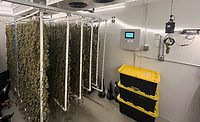Perfecting Panning for Cannabis-Infused Confections
Panned confectionery products are ideal cannabinoid delivery vehicles, but they require the right equipment and manufacturing expertise.




Photo from Getty Images.




With shiny coats and easy poppability, panned confectionery products offer enjoyable experiences in bite-sized packages. Their convenience, portability, and versatility also make them ideal for delivering cannabinoids.
“Panning is awesome,” says Michelle Frame, president and founder of Clara Food Technology, Chicago. “It is a process that allows a huge variety of items. (It) can be very meditative watching the bed of candy roll.”
The panning process includes coating — also known as engrossing — fruit, nuts, seeds, or other confectionery centers in sugar or chocolate by tumbling them in rotating pans. Successful panning operations must manage many considerations, both in terms of production and cannabinoid dosing, but these concerns can be alleviated with the right equipment and manufacturing knowhow.
Panning processes
Panning can be broken into two processes: sugar panning and chocolate panning.
Frame says sugar panning is further divided into two types: soft sugar shell, for products such as jelly beans and Boston peanuts, and hard sugar shell, such as chocolate lentils and gum pellets.
“Soft sugar allows for a huge range of flavors, colors, speckles, and blends,” Frame says. “It’s about a three-hour engrossing process that alternates between a non-crystallizing syrup and dry sugar. Hard sugar shell traditionally is done only with a crystallizing sugar syrup, often doctored with one to three ingredients that help keep the sugar crystals very small and to ensure crunch. It’s a much longer process, often taking eight or more hours.”
Frame adds a modified hard panning process can be sped up with dry sugar charges. With the right room conditions, she says this can increase efficiency by 30-50%. After a rest period, both soft and hard sugar panned items are polished with carnauba wax or beeswax and sealed with a confectioner’s glaze.
Meanwhile, chocolate panning requires untempered liquid chocolate to coat confectionery centers. Frame says a precoat can help the chocolate adhere to the center, while cold air cools and tempers the chocolate around each piece. After a rest period, chocolate panned items are polished with a gum or starch solution and sealed with a confectioner’s glaze.
Randy Hofberger, president, R&D Candy Consultants, Burlington, WI, says size uniformity of the centers is critical to making sure each picks up equal amounts of coating. Chocolate can be sprayed directly onto the centers, allowing for more uniformity, or it can be ladled in, which is a low-cost option, but requires “more art than science,” Hofberger says. He stresses the importance of properly calculating center weights beforehand and measuring throughout the coating process.
Frame says the type of chocolate and how much chocolate coats the center are also important factors to consider.
“The chocolate-to-center ratio is a large part of the eating experience, along with the choice of chocolate,” she says.
Frame and Hofberger both emphasized the need to control humidity in the production environment.
“Often, small manufacturers don’t have good control of their temperature and humidity environment or HVAC,” Frame says. “No panning will go well with humidity above 50%. 20-30% is better for hard panning, and 35-45% is best for soft sugar and chocolate panning. Humidity control is more important than temperature for all types of panning. Temperatures can range from 55-65 degrees Fahrenheit for chocolate and 68-72 degrees Fahrenheit for sugar shelling.”
As for ensuring proper per-piece dosing, Frame recommends dispersing cannabinoid material in the precoat or liquid phase and using an emulsifier if needed. She also recommends adding it early in the process or placing it on the centers before adding them to the pan.
“The absolute best method is placing the centers in a tray with divots and dosing each piece,” she says. “The next best is applying it in the early coats of chocolate or syrup and ensuring the pieces are well mixed before applying dry charges or air. In pans 16 inches or smaller, it is critical to move the bed of candy from front to back with your hand during this time. In larger pans, this is done by the rolling, so it isn’t necessary.”
Equipment focus
Food-grade stainless steel pans are an absolute must for panning operations, Frame says. She adds if the pan has ribs, it’s ideal if they have no welds.
“If the bowl is welded together, or ribs are welded in, make sure it is properly done for stainless, with clean welds that don’t have rough areas or pock marks that can allow for bacterial growth,” she says. “We recommend ‘bumped in’ ribs, where the wall of the pan itself has been modified to have what looks and behaves like speed bumps built in. These are gentle ribs that cause great tumbling, minimize sliding, and can be used for both engrossing and polishing.”
Otherwise, Frame says, engrossing pans should be smooth on the inside, and ribs should only be used for polishing. Ribbed pans are too harsh for engrossing, since they can cause chips and knicks.
Pilot-size pans with 16-inch or 24-inch bowls are ideal for cannabis products, since smaller pans don’t allow for compression or smoothing of the coating. Larger production pans — between 36 and 60 inches — require too much material, Frame says.
“A minor miss in dosage will lead to thousands of dollars of loss,” she says. “It is recommended that 16-inch or 24-inch pans are used. The benefit of 24-inch pans is that the rolling is better, reducing the amount a person needs to move the bed of candy around to ensure even coverage.”
Jim Greenberg, co-president, Union Confectionery Machinery Co., also says manufacturers of cannabis products typically purchase 12- to 24-inch pans, which produce batches between 5 and 40 pounds.
“The majority of the people that we deal with in the cannabis industry are panning to some extent,” he says.
Greenberg adds some manufacturers purchase multiple pans at once if they’re setting up duplicate operations in several states. He adds manufacturers should match their batch size to their production needs, as well as seek out portability and sanitary design.
Pans that allow manufacturers to adjust rotating speeds and pan angle offer more flexibility, especially when it comes to engrossing different centers, Hofberger says.
“The more adjustments you can make, the more you can fine-tune it,” he says.
No matter the size or capability of the pan, Frame encourages manufacturers to be patient. Adding layers of coating too soon can prove detrimental. And despite its complexities, she hopes they appreciate the journey and end results.
“Enjoy the innovation, method, and finished product of this fabulous process,” she says.
Image Source: Courtesy of Getty Images
This article was originally posted on www.cannabisproductsinsider.com
Looking for a reprint of this article?
From high-res PDFs to custom plaques, order your copy today!










